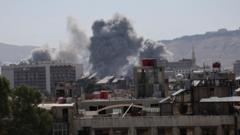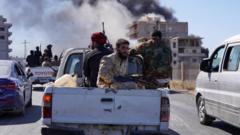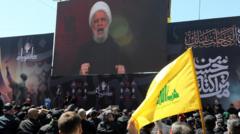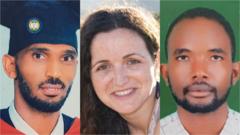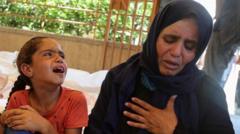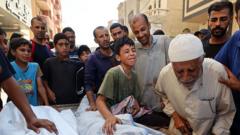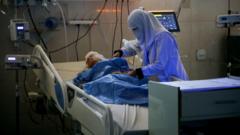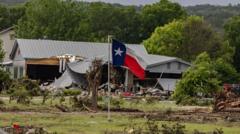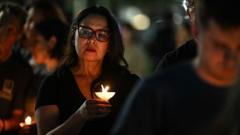In the wake of a catastrophic earthquake near Sagaing, a heartbroken former imam reflects on the overwhelming grief of losing relatives and a cherished community during a sacred time.
Myanmar Tragedy: Imam Mourns Loss of 170 Lives in Earthquake During Prayer
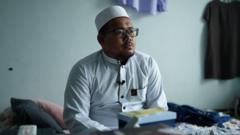
Myanmar Tragedy: Imam Mourns Loss of 170 Lives in Earthquake During Prayer
A devastating earthquake struck Myanmar, leading to the tragic loss of 170 lives as worshippers prayed in mosques.
Soe Nay Oo, once an imam at the Myoma mosque, has been living in Thailand after fleeing Myanmar's previous military coup. As hundreds gathered to pray, chaos erupted when the quake struck, leaving him mourning friends and family amidst an unrelenting tragedy.
On a fateful Friday last week in Sagaing, Myanmar, an earthquake struck, claiming around 170 lives as devout Muslims were gathered for their final prayers of Ramadan. As the call to prayer echoed through the city at midday, the tremors began, causing three mosques to collapse. Among the victims were many of Soe Nay Oo’s relatives and friends, devastating a community that faced tragedy amid a time of spiritual reflection.
Soe Nay Oo, a former imam who fled Myanmar after the coup in 2021 and now resides in the Thai town of Mae Sot, experienced the quake even from afar. Overcoming long distances and barriers, he grappled with the reality of having lost a significant portion of his congregation. Eyewitness accounts revealed a horrific scene, as many worshippers were trapped, either attempting to flee or buried beneath the rubble.
With the official death toll rising beyond 2,700, Soe Nay Oo expressed his tremendous grief to BBC News, sharing, “The loss is unbearable for us.” He recounted heart-wrenching stories of loved ones lost, such as his wife’s cousins—a well-respected businessman and a generous school principal who contributed to the community.
Tragedy struck as rescue efforts continued, yet complications rooted in ongoing military conflicts in the region exacerbated the plight of survivors. Access to burial grounds was hindered, forcing grieving families to transport bodies to Mandalay for proper Islamic rites. This delay caused further anguish, particularly as it conflicted with their cultural and religious practices of timely burial.
In addition to emotional distress, survivors faced immediate struggles for basic necessities. With food supplies dwindling and many left homeless, Soe Nay Oo, despite his internal turmoil, dedicated himself to coordinate assistance from his current location, driven by a sense of obligation to his former congregation.
“My heart is heavy, but I find some solace in helping,” he stated. Soe Nay Oo continues to wrestle with survivor's guilt, reflecting on his inability to physically assist his community during their darkest hour.
This heartbreaking incident serves as a reminder of the fragility of life amidst times of communal faith and the need for support and solidarity as Myanmar grapples with the dual impacts of natural disaster and socio-political strife.
On a fateful Friday last week in Sagaing, Myanmar, an earthquake struck, claiming around 170 lives as devout Muslims were gathered for their final prayers of Ramadan. As the call to prayer echoed through the city at midday, the tremors began, causing three mosques to collapse. Among the victims were many of Soe Nay Oo’s relatives and friends, devastating a community that faced tragedy amid a time of spiritual reflection.
Soe Nay Oo, a former imam who fled Myanmar after the coup in 2021 and now resides in the Thai town of Mae Sot, experienced the quake even from afar. Overcoming long distances and barriers, he grappled with the reality of having lost a significant portion of his congregation. Eyewitness accounts revealed a horrific scene, as many worshippers were trapped, either attempting to flee or buried beneath the rubble.
With the official death toll rising beyond 2,700, Soe Nay Oo expressed his tremendous grief to BBC News, sharing, “The loss is unbearable for us.” He recounted heart-wrenching stories of loved ones lost, such as his wife’s cousins—a well-respected businessman and a generous school principal who contributed to the community.
Tragedy struck as rescue efforts continued, yet complications rooted in ongoing military conflicts in the region exacerbated the plight of survivors. Access to burial grounds was hindered, forcing grieving families to transport bodies to Mandalay for proper Islamic rites. This delay caused further anguish, particularly as it conflicted with their cultural and religious practices of timely burial.
In addition to emotional distress, survivors faced immediate struggles for basic necessities. With food supplies dwindling and many left homeless, Soe Nay Oo, despite his internal turmoil, dedicated himself to coordinate assistance from his current location, driven by a sense of obligation to his former congregation.
“My heart is heavy, but I find some solace in helping,” he stated. Soe Nay Oo continues to wrestle with survivor's guilt, reflecting on his inability to physically assist his community during their darkest hour.
This heartbreaking incident serves as a reminder of the fragility of life amidst times of communal faith and the need for support and solidarity as Myanmar grapples with the dual impacts of natural disaster and socio-political strife.






